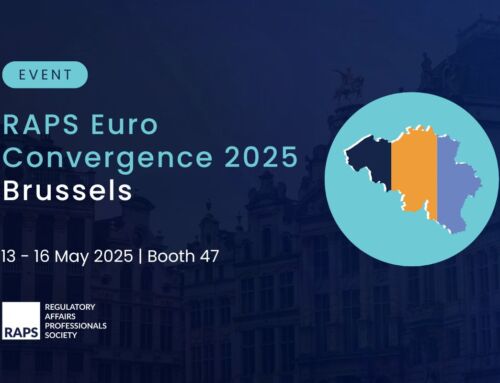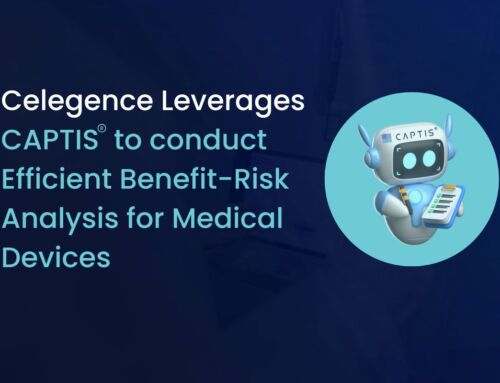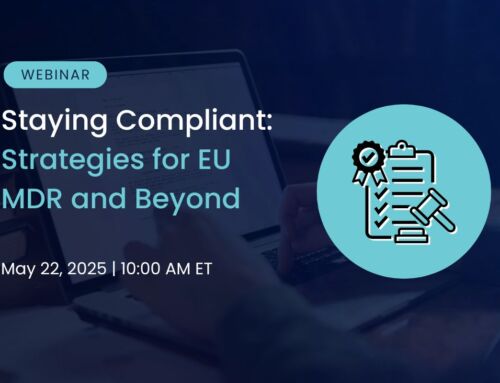
Dr Vaillot’s Presentation on the EU MDR Extension
Dr. Sophie Vaillot is the Head of Global Regulatory Affairs at Nobel Biocare Systems who is responsible for the overall regulatory compliance including regulatory strategy planning and execution – FDA pre-submission meetings, 510(k), CE marking, and global market access, as well as lifecycle management activities.
The EU commission at the end of the March postponed the date of application for medical device companies due to the uncertain COVID 19 situation. Implementing the specific requirements in compliance with EU MDR is still a big challenge for medical device manufacturers. During our RAPS webinar discussion titled “Taking Advantage of the EU MDR Delay in Uncertain Times: Optimizing Your Medical Device RA/QA Strategy”, Dr. Sophie Vaillot spoke specifically about MDR Overview, Timelines & MDR Delay – Impact and how to use it.
Why should you watch this video?
- This video (and transcript) will provide you with an understanding of what the EU-MDR extension means for your organization, and how the extra time should be leveraged for both new and legacy devices.
- You will be able to strategically plan for interactions with specific extra-EU situations: Switzerland and Turkey.
A full transcript of Dr. Sophie Vaillot’s is available to download (and to read below) and just press play to watch the clip now.

Claim Your Free EU MDR Checklist Now!
Make sure you and your business are compliant with the new EU MDR. Get our 23 page checklist for actionable technical documentation requirements.
Well, thank you, everyone, for attending this webinar. I am very excited to be here today and to discuss the MDR and more specifically, this new date of application, and how the industry can benefit from it.
MDR – A Long Journey
Before getting into the specifics of this additional year and the impact of this delay, I’d like to just take a quick step back, maybe for those who were not part of the regulatory world just 10 years ago, to have a quick look at the MDR journey, which is actually a long one. It started more than 10 years ago, with the public consultation from the EU commission to update the medical device directive.
So that led to multiple versions of a new regulation, with multiple versions going back and forth between the different legal entities of the European Union (EU), before getting to a compromised text, which was finally adopted and published in May 2017. The date of application at that time, was to be three years later in May 2020. So, the text has already been amended and changed from the original text through corrigendum, and with some delegated and implementing acts.
So, why such a long journey? Well, first, because of the complexity of the legislative process in Europe. They must work with different notified bodies, which need to approve and agree on the text and requirements. And because the MDR is so complex, the text brings several new requirements and concepts into regulation.
MDR 2017 / 745 at a Glance
Some of these new concepts are coming from work that was previously done at the international level. First through the GHTF work, and then through the IMDRF directive, which can be seen in the introduction of the UDI of different requirements around the technical file, and strengthening the PMS requirements as well. So, the MDR brings lots of new concepts and specific requirements. I am not going to go into detail here because Royth is going to mention them later on.
DOA of MDR 2017/745 Pushed by 1 Year – MDR 2017/745 New Timelines
So, what happened just recently at the end of March, just short of two months before the date of application, the EU commission actually shared that they were working on a proposal to postpone the date of application. This is something that had already been brought to their attention by the industry, through Trade Associations, and was supported by regulators, and actually some of them, maybe unofficially, supported them. But that’s not something that the EU commission was willing to pursue given the COVID situation. They realized that given the new circumstances, challenging environment, and the need for notified bodies, regulators and the EU commission had to focus on COVID19 related medical devices and identities, and there was a need to postpone the date of application.
So, again, that’s kind of a complex legislative process that had to be implemented, where all defendants, the three legal entities, had to act to agree on the proposal. The EU commission was able to run that pretty smoothly, and over a month later after the initial communication, at the end of April, the regulation amending the MDR was actually published with immediate effect. Which then resulted in the postponement of the date of application, with the date now being May 26th, 2021. So, as we are going to see (in the graph) changes later on this year, there are some timeline’s that are not impacted by this amendment to the regulation.
MDR 2017/745 – 1 Additional Year? For Whom, for What?
What is important to keep in mind is that this additional year is not a gift to the industry. Firstly, it is providing more time for the regulators and the notified bodies to complete the designation process. Hopefully, MDR designated notified bodies will be able to process the authority & the industry requests. It is more time for the notified bodies to continue working on the rollout and the certificate conversion. It’s more time as well for the EU Commission to continue drafting and publishing the pending publications. There are actually several MDCG guidances which are still pending, and are due between now, and the end of the year. It is also more time to continue working on the EUDAMED implementation, and making sure that the new timelines of EUDAMED for 2022 are met.

Claim Your Free EU MDR Checklist Now!
Make sure you and your business are compliant with the new EU MDR. Get our 23 page checklist for actionable technical documentation requirements.
The Industry’s Readiness
Even if it is not a gift to the industry, that does not mean that the industry is not going to be able to benefit from it. Based on a recent survey that was published by Greenlight Guru, it seems that a large portion of the industry is welcoming of an additional year. But a vast majority of the industry members stated they were not MDR ready, and were not confident that they would pass an MDR audit. About half of them are still saying that they do not have the budget to be able to implement MDR compliance.
Take Time to Carefully Assess your Situation!
So, for everyone, this is time that can be used to actually address these weaknesses, so the first thing to do is to take the time to carefully assess your current situation. And then again, that is going to be dependent on your own organization, and where you are in the MDR implementation process. For example, is your MDD certificate already renewed? Is your NB already MDR designated?
If so, have you already started to plan your audits? Do you have a schedule for the coming months? And do you know the different timelines that you need to meet? If your NB is not yet MDR designated, do you have an idea of when that will be the case? Then you can start working on that to plan the different steps that need to be completed.
Do you have all the MDCG guidelines? Which ones are coming in, and which ones are going to be impacting your products or your processes? Did you take the time to formally train your different employees and keep track of these training sessions? Because this is actually something that is often requested by NBs.
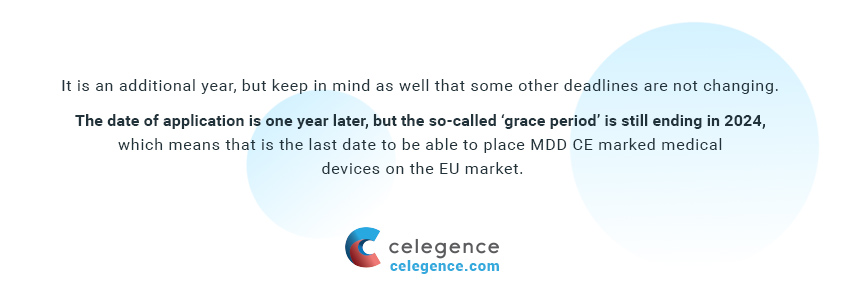
MDR 2017/745 – 1 Additional Year? But Keep in Mind
It is an additional year, but keep in mind as well that some other deadlines are not changing. The date of application is one year later, but the so-called ‘grace period’ is still ending in 2024, which means that is the last date to be able to place MDD CE marked medical devices on the EU market.
The date of application is changing, but not article 120 of your MDD certificate that has already been extended. This gives you more time to ask for a renewal of the MDD certificates, but some notified bodies have stopped actually accepting these renewals based on the upcoming date of application. So, you would need to check with your notified body about what your current position is, and that is something that you can benefit from.
Extra Time for MDD Legacy Devices
There are a few things that you can still do regarding your MDD legacy devices.
Planned to exit the EU market for some parts of the Portfolio? – The first thing is that I know some of the industry members are actually planning to exit the EU market for some of their medical devices. When that is done, you don’t want to invest into MDR compliance for those devices, which makes sense from a business standpoint. This gives you some extra time to continue placing them on the market and maximizing the life of all of these products.
Considering making any changes to legacy devices? –This additional year until the date of application also allows more time to continue working with your NB to understand how they would accept changes made to these products, and to these devices already CE marked. Additionally, how they would apply either the guidance on the significant changes, or NBOG one of substantial changes. So that requires, again, a discussion with your notified body and how that can be applied. But that is just one option that you have and some extra time to work on that.
Extra Time for PMS Activities – Collecting Data
So, an additional year is also extra time to be fully ready for the MDR and specifically for some specific new requirements which have been introduced regarding the PMS activities that you need to have. So, you may not need it right now, but you are going to need it in a year or so. So, this is some more time to make sure that you have the right channels to collect that information, and that you have the right level of information. I would say specifically in these new environments where clinical practice may change, you may need to adapt, for example, the questions of the survey that you had sent to your customers in order to collect their feedback.
You may also need to look into how you are collecting this feedback if you were relying on on-site visits. You may want to change and adapt that to the new working environment.
Extra Time to Deal with Specific Extra-EU Situations: Switzerland
The date of application being postponed gives extra time to deal with some specific situations like the European situation. One example is Switzerland. Currently the MDD is fully recognized there. There is an agreement in progress between Europe and Switzerland, and it is considering all the requirements of the MDD, but that is not the case yet for the MDR. So there is also some extra time for both parties to reach an agreement to make sure that it fully includes MDR requirements.
And actually, the Swiss administration confirmed yesterday that they were working on that and that they were still discussing with the EU Commission in order to reach that agreement. But that is not something that has happened yet, so it is not fully certain. This is extra time for you as a manufacturer, specifically a legal manufacturer based in Switzerland, or if you are an authorized representative based in Switzerland, to look for a Plan B in case this mutual recognition agreement is not fully in place by May 2021.
Extra Time to Deal with Specific Extra-EU Situations: Turkey
Similarly, even if it is a different situation, due to the status of Turkey, there is Turkish legislation that is aligned with the MDD with some additional requirements. But again, this is not yet the case for the MDR. And in addition to the MDR being transferred to the Turkish legislation and the European Union, there will soon be a need to have a specific new agreement to deal with MDR CE marked products. That is more time for these two parties to continue working and to reach an agreement by mid-2021. And if that’s not the case, that’s more time for the members of the industry to decide how big Turkey’s market is for you, for example, how you can prevent the adverse consequences of that. This means stockpiling, and making sure that you have products introduced on the Turkish markets before the cut-off date.
Extra Time to Assess Impact of Changes on International Registrations
More generally speaking, there is also extra time to see the impact of the MDR and anticipate the impact of the MDR on international registrations. This is so you don’t have any adverse consequences for the date of application. As you know, the MDR is going to have some impact on the regulatory labeling, the technical documentation, and administrative documentation, with all of those being used for international registration. So, you may want to see how that is going to impact your registration and how you can combine these changes with upcoming new registrations that you want to make. This is so you do not end up registering your product several times in a couple of months.
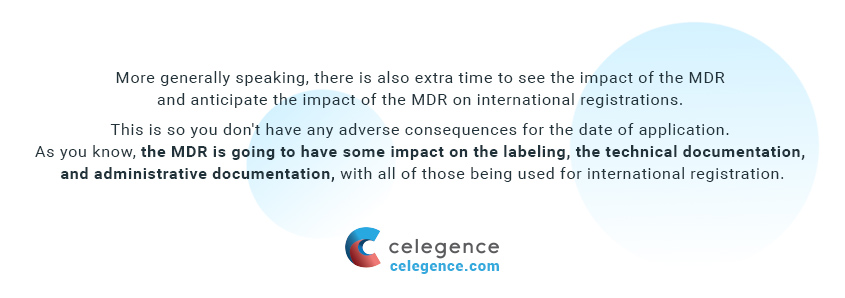
Conclusions
As a conclusion, the date of application is coming in about 308 days. So, take the time to assess the situation, but also use the time wisely based on what your situation is. Thank You!!
